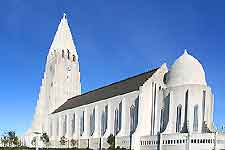Reykjavik History Facts and Timeline
(Reykjavik, Capital Area, Iceland)

Whilst the modern city of Reykjavik really began to establish itself during the 18th century, its history is in fact considerably longer. Towards the end of the 9th century, Nordic traveller Ingolfr Arnarson arrived in this part of Iceland with his fellow Norsemen and founded the country's earliest known settlement.
It is widely acknowledged that Arnarson selected this spot by employing a traditional Viking method for choosing where to land. He simply threw some wooden poles overboard when the shoreline became visible and watched where they were washed up - this was to become the future city of Reykjavik. This name literally translates as 'Bay of Smoke' and was adopted due to the plentiful geothermal hot springs around the area. Interestingly, Viking remains have since been discovered close to the public square of Austurvollur.
Development in the 18th Century
Although Reykjavik does hold a medieval history of some sort, little is known or remembered of this period. Instead, it is the 18th century that most history books state as the time when an urban settlement grew up here. Led by the Danes, Iceland was keen to promote domestic trading and industry, and so in the early 1750s, Frederick V of Denmark chose to donate this land to the enterprising Innréttingar Corporation.
Houses were quickly built and an important wool industry began to thrive, bringing great wealth to the town for several decades. Agricultural also played a part in the growth of Reykjavik at this time, along with the building of ships and the mining of sulphur, as well as the staple income earned by fishing.
An Exclusive Trading Charter
A new chapter began in 1786, when Denmark decreed that Reykjavik was to become one of just six communities throughout Iceland to be granted an exclusive trading charter, although Danish traders remained an integral part of the country's economy. Icelandic people consider 1786 to be the official year of the city's founding and celebrate its anniversary accordingly. The following decade saw the arrival of free trade, and merchants from all over Iceland started to gain a foothold in the world of trading.
Icelandic Nationalism and the World Wars
During the 19th century, residents of Iceland began to campaign for the independence of their country, realising that Reykjavik was to be a key player in this cause. A subsequent struggle for independence began, with minor progress made in 1874, when the country was given some additional legislative powers. The year of 1918 also marked an important moment in Reykjavik history, with Iceland becoming known as a sovereign country, although it was still very much under the control of Denmark.
The city established a successful fishing fleet and the trade of salted cod marked a brief period of growth after the end of the First World War. Unemployment followed in the late 1930s, when the Great Depression made an appearance. Soon after, 1940 heralded the occupation of Denmark by the Germans, and a number of warships were watching Reykjavik from a distance, being moored up in its harbour. At first the locals panicked, believing these to be German ships, although they soon realised that the British had arrived and chose to allow a peaceful invasion and occupation.
Towards the end of World War II, both the British and the Americans had based themselves in the Icelandic capital, building military bases and almost outnumbering the residents. Reykjavik Airport was soon completed by the British, while the Americans built a further airport in the nearby town of Keflavik, within the Reykjanes region.
Post-War Years
The 1950s onwards became something of a boom time for Reykjavik, with the city enjoying continued growth and success. Reykjavik welcomed families from more rural areas and gained a modern infrastructure.
Over the years, the city hosted a number of significant international events, such as the World Chess Championships in 1972, and the Reykjavik Summit of 1986, attended by US president Reagan and Soviet leader Gorbachev. Icelandic singer-songwriter Bjork was born here in 1965 and grew to received worldwide acclaim for her distinctive electric pop music.
For tourists coming to the capital and looking for an insight into Reykjavik's history, its plentiful museums are a good place to start. The National Museum of Iceland is especially notable, being established way back in the 1860s to preserve some of Iceland's most noteworthy heritage artefacts.
 Whilst the modern city of Reykjavik really began to establish itself during the 18th century, its history is in fact considerably longer. Towards the end of the 9th century, Nordic traveller Ingolfr Arnarson arrived in this part of Iceland with his fellow Norsemen and founded the country's earliest known settlement.
Whilst the modern city of Reykjavik really began to establish itself during the 18th century, its history is in fact considerably longer. Towards the end of the 9th century, Nordic traveller Ingolfr Arnarson arrived in this part of Iceland with his fellow Norsemen and founded the country's earliest known settlement.